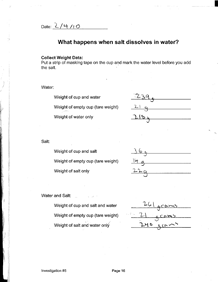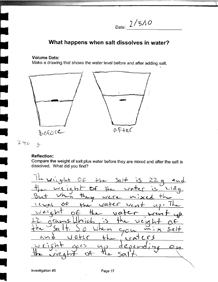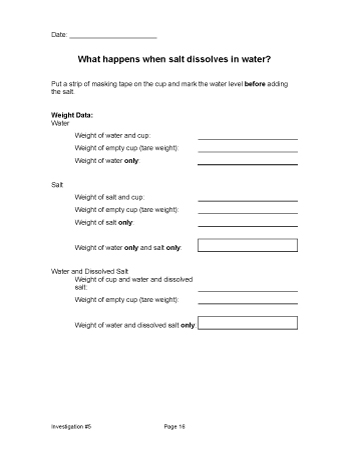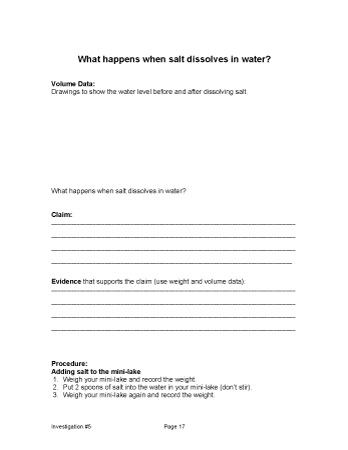What changes and what stays the same when salt dissolves in water?
Plan Investigation 5
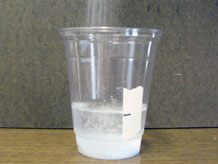
Start with a single grain of typical table salt. Divide it into a billion equal-sized pieces, and then divide just one of those billion pieces into a billion equal-sized pieces. If you do this carefully, each of those smallest pieces will be the size of a single molecule of sodium chloride, the substance we call salt. Is a molecule of salt smaller than you thought? Do you think it weighs anything?
Yes, the 4-pound box of table salt has weight because each of the more than 22.5 million grains of salt in the box has weight, and each of the grains has weight because each molecule of salt has weight. This unit does not address the concept of molecules, but it does continue one important idea that students have been building over the past few sessions: very tiny things have weight.
Formative Assessment
Available online at inquiryproject.terc.edu
Have your students collected accurate weight and volume data that they use to support a claim about what happens to salt when it dissolves in water?
Look for evidence in the notebook entries. What happens when salt dissolves in water? Without accurate data, students will be unable to support claims that dissolved salt is present in the water even though it’s invisible.
Use these criteria to interpret students’ work:
- Is the weight of water alone plus the weight of the salt added equal to the weight of dissolved salt and water?
- Does the drawing of volume data show that adding salt increases the water level?
Once students have collected and recorded accurate data, the next step is to ask them to make claims about whether dissolved salt still exists in the water even though you can no longer see it, and to use the weight and volume data they just collected to support their claims.
Today we extend the idea that there is power in numbers. When students grind up kosher salt, the size of each piece decreases but the number of pieces increases; the weight does not change. The same thing happens when dissolving salt in water: the pieces become extremely small (too small to see), but when students weigh the container and salt before and after dissolving they discover that the weight does not change. The dissolved salt maintains its weight.
By the end of this investigation students will understand that tracking the weight of a substance as it is transformed through crushing and dissolving can provide clues about what is happening. They will deepen their understanding that small things have weight and take up space and, that if the weight of a sample is unchanged, the amount of matter must be conserved.
Learning Goals
- Understand that weight stays the same as a substance is dissolved
- Understand that things too small to see have weight and take up space
| Sequence of experiences | ||
|---|---|---|
| 1. Ask the question | All Class | 5 Mins |
| 2. Explore | Individual | 5 Mins |
| 3. Demonstrate dissolving | All Class | 5 Mins |
| 4. Dissolve salt in water | Pairs | 20 Mins |
| 5. Make meaning | Discussion | 10 Mins |
Materials and Preparation
Preparation:
- Review 315 Dots per Page (See Resource Quick Links)
- Measure and post the tare weight for a clear plastic 12oz cup.
For the class:
- Post the investigation question in a place where all students can see it.
- Dot Sheet 1 [pdf] and Dot Sheet 2 [pdf] (See Resource Quick Links)
- 1 12oz clear plastic cup approximately 1/2 full (approx. 160g) with water
- 1 12oz clear plastic cup holding 2 rounded teaspoons (approx. 20g) of kosher salt
For each group (first set of materials, for exploring salt):
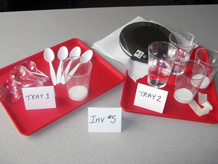
- 1 12oz clear plastic cup holding approximately 1 teaspoon kosher salt
- 4 magnifiers
- 4 plastic spoons
For each group (second set of materials, for dissolving salt in water):
- 1 digital scale
- 2 12oz clear plastic cups, each approximately 1/2 full (approx. 160g) of water
- 2 12oz cups, each holding 2 rounded teaspoons (approx. 20g) of kosher salt
- 2 paper towels
- 2 short pieces of masking tape
For each group (third set of materials, for use with mini-lakes):
- 2 12oz cups, each holding 2 rounded teaspoons (approx. 20g) of kosher salt
Note: Kosher salt, unlike typical table sat, contains no iodine or anti-clumping additives and so leaves water completely clear after it fully dissolves.


